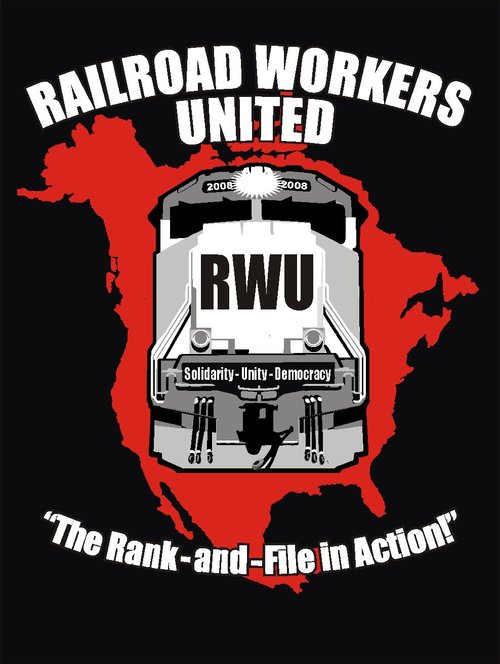At the 3/12 General Membership Branch meeting, the Northeast Ohio IWW voted to approve the following resolution in support of the Railroad Workers United push for public ownership of U.S. railroads. While the resolution is a statement of support, it is also a powerful and detailed indictment of the rail industry. It states the case for public ownership and democratic worker control of North America’s rail industry in clear language. The resolution reads as follows:
Whereas, rail infrastructure the world over is held publicly, as are the roads, bridges, canals, harbors, airports, and other transportation infrastructure; and
Whereas, numerous examples of rail infrastructure held publicly have operated successfully across North America for decades, usually in the form of local/regional commuter operations and state-owned freight trackage; and
Whereas, due to their inability to effectively move the nation’s freight and passengers during WWI, the U.S. government effectively nationalized the private rail infra-structure in the U.S. for 26 months; and
Whereas, at that time it was agreed by shippers, passengers, and rail workers that the railroads were operated far more effectively and efficiently during that time span; and
Whereas, every rail union at that time supported continued public ownership (the “Plumb Plan”) once the war had ended; and
Whereas, specifically, when the rank & file rail workers were polled by their unions in December 1918, the combined totals were 306,720 in favor of continued nationalization with just 1,466 in favor of a return to private ownership; and
Whereas, the entire labor movement at that time was in favor of basic industry being removed from private hands, with the delegates to the 1920 AFL Convention voting 29,159 to 8,349 in favor, overruling the officialdom of the AFL and its conservative position; and
Whereas, in the face of today’s crumbling infrastructure, crowded and clogged highways and city streets, poor air quality, lack of transportation alternatives and deepening climate crisis, expanded rail transportation – for both freight and passenger – presents a solution to these social ills and problems; and
Whereas, the rail industry today however is contracting – rather than expanding – at a time when we need more trains, trackage, rail workers, and carloads, not fewer; and
Whereas, the private rail industry is moving 5 to 10% less freight than it did 16 years ago, and in recent years has shuttered diesel shops and classification yards, and has drastically reduced the number of employees; and
Whereas, the private rail freight industry is generally hostile to proposals to run any additional passenger trains on their tracks – despite having legal common carrier obligations to do so – making it difficult if not impossible to expand the nations’ passenger rail network; and
Whereas, the rail industry has come to focus solely on the “Operating Ratio” as a measure of their success, and in doing so have engaged in massive stock buybacks and other measures that deliver short-term gains for stockholders but at the expense of the long-term health and vitality of the industry; and
Whereas, the Class One carriers’ failures to move freight effectively have contributed greatly to the ongoing supply chain crisis, resulting in some of the highest inflation rates in many years; and
Whereas, these “Fortune 500” corporations have raked in record profits, in both “good” years and “bad”, right through the “Great Recession,” the pandemic, and otherwise, right up to the most recent Quarterly financial announcements; and
Whereas, during these years of record profits, these same Class One carriers have:
• Failed to solicit nor accept new but “less profitable” freight traffic.
• Forwarded less freight than 16 years ago.
• Stonewalled practically every attempt by Amtrak and other agencies to add passenger service.
• Failed to run Amtrak passenger trains on time, despite regulation and law to do so.
• Downsized the infrastructure, physical plant, and capacity.
• Eliminated nearly a third of the workforce.
• Outraged shippers and their associations by jacking up prices, providing poor service, and
• Assessing new demurrage charges.
• Thumbed their nose at state and federal governments.
• Blocked road crossing and increased derailments by the implementation of extremely long trains.
• Threatened and attempted at every turn to run trains with a single crew member.
• Opposed proposed safety measures, from Positive Train Control (PTC) to switch point indicators;
• The End-of-Train Device (EOT) to Electronically Controlled Pneumatic Brakes (ECP).
• Taken a hostile stance towards the myriad unions, refused to bargain in good faith, consistently demanding concessions, all the while expecting these “essential workers” to labor through the pandemic without a wage increase.
Therefore, Be It Resolved that the NORTHEAST OHIO IWW GENERAL MEMBERSHIP BRANCH supports the public ownership of the rail infrastructure of the U.S., Canada, and Mexico, under democratic workers’ control, to be operated henceforth in the public interest, placed at the service of the people of all three nations; and
Be it further resolved that the Northeast Ohio IWW GMB supports the Rail Workers United movement for public ownership, and,
Be it Further Resolved that the NORTHEAST OHIO IWW GENERAL MEMBERSHIP BRANCH urges all of its members to voice their support for this proposal; and
Be it Further Resolved that the NORTHEAST OHIO IWW GENERAL MEMBERSHIP BRANCH urges all other IWW branches, industrial unions, and chartered bodies to take a similar stand; and
Be it Finally Resolved that the NORTHEAST OHIO IWW GENERAL MEMBERSHIP BRANCH urges all labor unions, environmental and community groups, social justice organizations, rail advocacy groups and others to push for a modern publicly owned rail system, one that serves the nation’s passengers, shippers, communities, and citizens.
